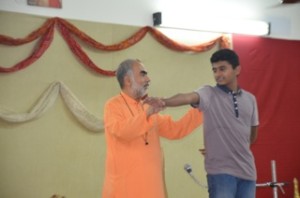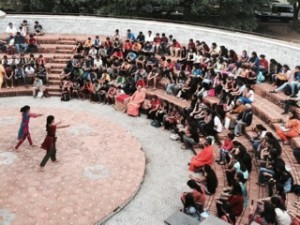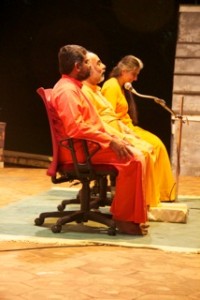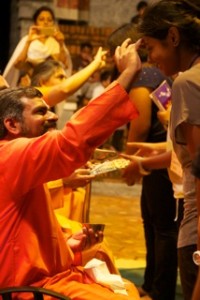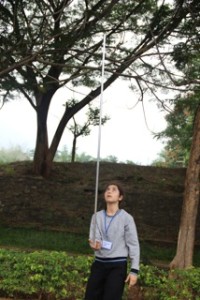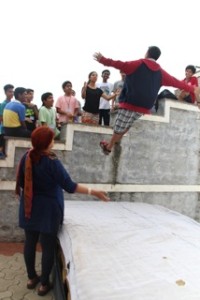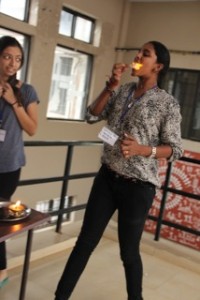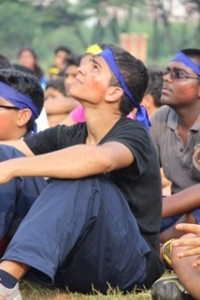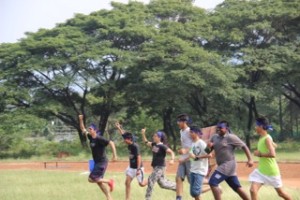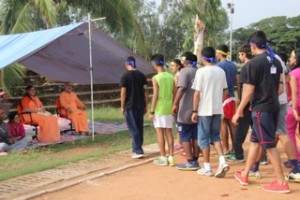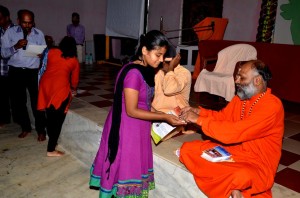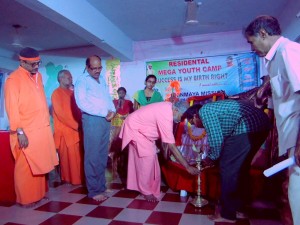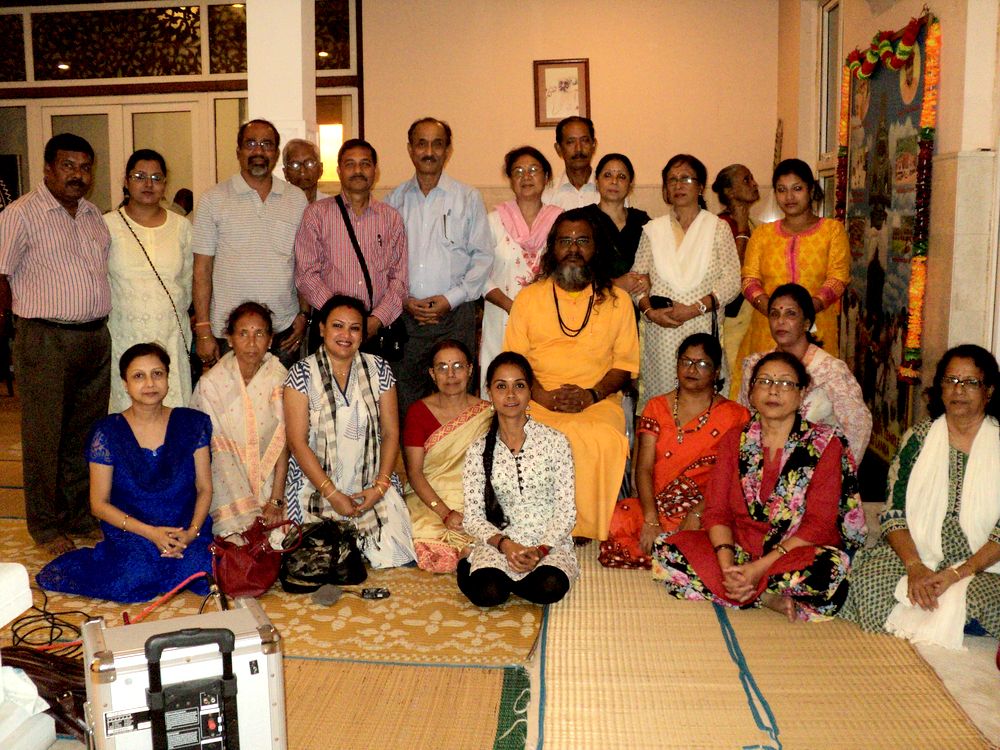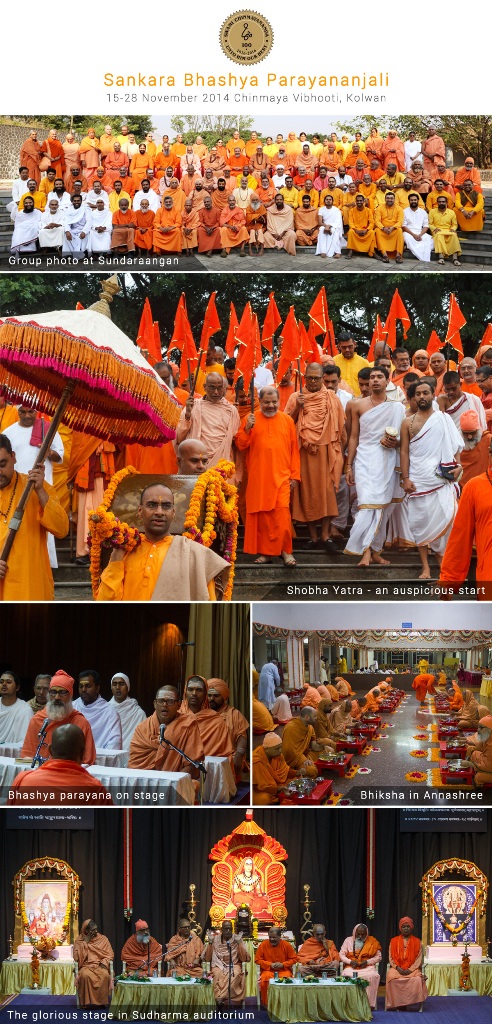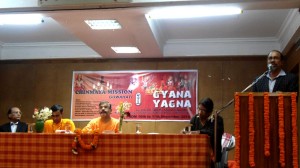 The most awaited Gyan Yagna by Swami Advaitananda in Guwahati was inaugurated on 10th Dec’14 and continued up to 14th Dec’14. The morning text was “Adi Shankara’s Aporakshanubhuti” and the evening text was “Sundar Kanda” from Ramayana. The devotees who turned up in numbers braving the December’s cold were hugely inspired with Swamiji’s lucid deliberations on both the texts. Swamiji’s discourse linking the texts with real time application and with lively examples enlightened the participants with the learning of tips for a happier life. During his stay Swamiji also blessed the Executive & Devi Group members and advised how individually the members could contribute to the growth of Chinmaya Mission for the benefit of society and spreading happiness.
The most awaited Gyan Yagna by Swami Advaitananda in Guwahati was inaugurated on 10th Dec’14 and continued up to 14th Dec’14. The morning text was “Adi Shankara’s Aporakshanubhuti” and the evening text was “Sundar Kanda” from Ramayana. The devotees who turned up in numbers braving the December’s cold were hugely inspired with Swamiji’s lucid deliberations on both the texts. Swamiji’s discourse linking the texts with real time application and with lively examples enlightened the participants with the learning of tips for a happier life. During his stay Swamiji also blessed the Executive & Devi Group members and advised how individually the members could contribute to the growth of Chinmaya Mission for the benefit of society and spreading happiness.
Author Archives: Web Master
Book Exhibition by CM Dombivali
A book exhibition was organized in Dombivli as a part of Pujya Gurudev Swami Chinmayananda’s birth centenary celebrations at Brahmin Sabha hall from Dec 20 to Dec 22, 2014.
The exhibition was inaugurated by Mr. Uday Karve the chairman of Dombivli Nagri Sahakari Bank Ltd.and by Ms. Sheela Modak (president Chinmaya Mission, Dombivli) in the presence of Vivekji & Varshaji.
The book fair was a spectacle to watch. Books on wide range of topics like, Bhagvad Geeta, Advanced Vedanta, Upanishads were displayed. Every stall was very impressive but the most attractive among all was the children’s book stall. It was crowded with small children and their friends with their parents. They enjoyed purchasing pictorial and colourful books.
Discount coupons were given to some of the reputed schools, so that the children could buy wide range of books. Chinmaya Mission publications were showcased in 11 stalls segregated according to the topics including CDs & DVDs and Chinmaya Upahar as well.
Unto HIM our BEST
Please visit our FB post here to see the pictures of the exhibition
CM Ahmedabad Upanishad Ganga Lecture series Dec 2014
A report on Upanishad Ganga based Lecture Series II conducted from 22nd to 25th December 2014 at Ahmedabad Management Association. (AMA)
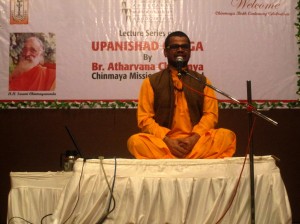 To gear-up for Pujya Gurudev’s Birth Centenary year celebrations, under the guidance of Br. Atharvana Chaitanya the third phase of the series of talks based on “Upanishad Ganga” was organised at AMA as a humble offering to Pujya Gurudev.
To gear-up for Pujya Gurudev’s Birth Centenary year celebrations, under the guidance of Br. Atharvana Chaitanya the third phase of the series of talks based on “Upanishad Ganga” was organised at AMA as a humble offering to Pujya Gurudev.
The four days lecture series focusing on the four Ashramas of human life comprised of 90 minutes sessions wherein everyday the auditorium was filled with over 160 enthusiastic students of all age groups. After a short talk highlighting the scriptural viewpoint on the topic of the day, the relevant episodes of “Upanishad Ganga” were screened. This was followed by a short discussion and a question-answer session. The titles for the talks and a brief summary of the content thereof are as follows:
1) Student Life Aspiration (Brahmacharya Ashram):
A brahmachari is the one who is focused on his endeavour of gaining knowledge and reaching the supreme Truth He is the one who conserves energy and channelizes it towards gaining knowledge. Br. Atharvana Chaitanyaji explained that surrender, clarity of thought, self discipline, purposeful self-denial, faith and service are the cornerstones of life of a student. During this phase of student-life the only duty one has to perform is to obey one’s Guru. In this phase of life, with total commitment to obey his Guru the student forgoes his own likes and dislikes. The touching story of Jabala’s son Satyakam mesmerized the audience and indicated the importance of thinking and questions in our life. This story lucidly conveyed that a Guru always comes to a sincere student who has within a desire to know irrespective of his caste, creed or culture. It highlighted that a burning desire to gain knowledge is the only requirement to qualify as a student.
2) Household Duties (Grihastha Ashrama)
A Grihastha (householder) is the one who holds the house together and not the one who is held by the house. It is said that “ चतुर्णामाश्रमाणां हि गार्हस्थ्यं श्रेष्ठमाश्रमम्।’’ Out of the four ashramas, it is only in grihastha ashrama that one has the privilege to attain the goals (Purusharthas) such ‘Artha”, and ‘Kama’ therefore it is considered to be the most interesting ashrama of the four ashrams of human life. Quoting the commentary of Sri Adi Shankaracharyaji on Prashnopanishad, Br. Atharvana Chaitanyaji very beautifully explained certain seemingly negative but inevitable facets of Grihastha ashrama to be able to deal with the society in an unruffled and effective manner. However he also highlighted that with these privileges, come the duties of a Grihastha which are to walk the path of karma yoga i.e performance of one’s duties as offerings unto the Lord and accepting the results with Prasadbuddhi and at the same time serve the society with a clear understanding of one’s role in the society. Everyone could relate to the entertaining episode based on “Mahakavi Maagha”, in which, the character “Siddharthak” was loved by all.
3) The Art of Retirement (Vanaprastha Ashrama)
This is an important stage in life where, from being a limited entity of a householder, with a strong sense of ownership we choose to move on to the next stage of life, which is -Vanaprasta. This comes from the words, Vana (forest) and Prasthaan (to go), which means to walk out of our limited identification of “my home” and “my family”, and expand by embracing the whole world as my home. Br. Atharvanaji explained it through a beautiful analogy of a caterpillar. The caterpillar, in the larva stage, keeps eating until it reaches the pupa stage. Eating (in the larva stage) here refers to the Grihastha stage where one builds wealth, knowledge, relationships etc. Having eaten enough, the larva becomes a pupa and finds a peaceful place, & starts weaving a cocoon around itself. This stage is the Vanprastha ashram. Where, having fulfilled all the responsibilities, one hands them over to the younger generation. Time is then spent on diving deep into the inquiry of the Self. Thus when we give up all attachments we make our own homes a “Tapovanam” (forest of austerities) and live in peace, seeking nothing but the higher. The episode on “King Dhritarashtra” and the King of Magadha “Bimbisar” brought out very well the sorrow faced by the one who is unable to free himself from the worldly attachments.
4) Winning in the game of Life (Sanyaas Ashrama)
Br. Atharvana Chaitanya explained that the last and ultimate Ashram of Human life Sanyaas is the act of giving up well. Then the question comes what is to be given up? It is the act of giving up one’s attachments towards the worldly objects and one’s own ego. Continuing the analogy of the caterpillar, Brahmachari ji said, the final transformation of the caterpillar into a beautiful butterfly is Sanyasa – where, the whole world becomes your family (Vasudhaiva Kutumbakam) and Sky is the limit to achieve anything. However, it is not merely a physical act of refraining from objects, but it is a state of maturity where one renounces the lower to pursue the Higher (The Supreme). It is the renunciation of the doer-ship and enjoyer-ship and being established in the Truth. Such a state is attained through purity of mind, clarity of knowledge and maturity in detachment. Two episodes of Upanishad Ganga were screened; one each based on the patriotic sanyaasi Shri Vidyaaranya Swami and the realised sage Yaajnavalkya.

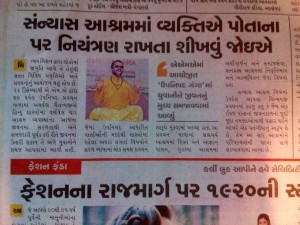
Global Teen Camp held at CIRS
Let the Games Begin! 140 teenagers gathered at CIRS in December for the third annual Global Teen Camp. Having no idea what to expect, they arrived with great anticipation. As Swami Swaroopanandaji started talks on the Vibishan Geeta, they sat spell bound, learning about courage, patience, fortitude, sweetness of speech and more. And as they learnt, so they experienced. To build courage, they ate fire, to test their patience they built towers out of rocks, to build devotion, they practised likitha japa.
But the excitement didn’t end there. Swami Anukoolananda and Swamini Supriyananda brought the teachings to life as the teenagers spent an evening camping out, cooking their own food and playing capture the flag, re-living a tiny fraction of what it would have felt like to go into battle. The impact on the teenagers was immense as the importance of teamwork, leadership and dealing with emotions dawned on them.
As one teenager said “Swamiji answered all my questions without me asking them. Everyone always tells us to be honest, to be strong, to be patient but nobody ever tells us how. Swamiji taught us how.”
The teenagers arrived as 140 individuals. They grew, transformed and left as an inspired family ready to face their challenges. Most importantly they learnt how to laugh, love, and live with courage, patience, honesty and devotion while playing the game of life! Let the games continue….
Peace and Harmony in Society
The most profound peace message in any of our scriptures, in Vedas and in Upanishads is the peace invocation also knows as Shanti Mantras. All Vedas and their studies begin with the invocation of peace, Shanti. Therefore the most fundamental or essential teaching in the Vedas is that of peace or Shanti; wherein peace is sought for ourselves and for our surroundings. One such peace invocation is very popular, between the Teacher and the taught.
Om Sahanavavatu sahanau bhunaktu
Sahaveeryam karavavahai
Tejasvinavadheetamastu ma vidvishavahai
Om Shanti Shanti Shantihi ||
This is an invocation to the almighty God, by both Teacher and student, before the commencement of their dialogue. The Teacher and student pray for peace in the surroundings as well as peace in the minds of teacher and student. That this knowledge should shine forth in our understanding and our lives and that it should not remain as book knowledge. This peace invocation also dispels any unwanted dislike for each other in the hearts of the Teacher and student. Therefore peace and harmony are the fundamental principles taught in our scriptures. This peace that we seek, our scriptures say, can be gained by understanding and inculcating the concept of Advaita or non-daulity (oneness). Simply put, by eliminating perceived divisions and differences from our minds. Physically differences cannot be removed as people and objects are different; however in understanding, know that all that is perceived and seen is none other than Truth alone. That Truth alone is the Reality, everything else is an appearance of names and forms or an effect of that Ultimate Reality. The world as we perceive is filled with differences, whether it is names forms or attributes. Moving away from this world of perceived names, forms and differences will bring us closer to the ultimate Reality which alone will allow the internal peace within us to shine forth. Consequently there is no real reason for conflict when we understand that the name-less, form-less, attribute-less is none other than our own true Self.
Satyam, Jnanam, Anantam, Advayam, Anandam.
That which is the Truth is knowledge and shines forth as non-dual infinite bliss. This is to be sought within: Nihitam guhayam, so-ashnute sarvan Kaman saha (taittiriya Upanishad). We often wonder about existence of God and where to locate him? Here I have an anecdote. There was a class for children where the teacher asked them, “ where is God ?” One answered that God is in the temple, another said God is everywhere and yet another that God is in our hearts. One child however declared “God is in my bathroom. My father gets up every morning and knocks on the door and says “Oh God, you are still inside”! So God is everywhere, but if we do not cognize this fact, we will say He is somewhere. In our childish nature we may limit God who is unlimited. Therefore unless we have the right understanding of God (Reality), we will never be able to see the truth as it is. That is why it is said that in order to know the Truth at absolute plane, we should have peace and harmony in our relative plane also. We should have goodness. Those are the values.
The Yoga Vashishta says: Shivam sarvatragam shantam bodhatmakam ajam shubham. The purpose of the gathering here today is to underline peace and harmony in scriptures. If we look at Vedantic scriptures and the four factors that tie the student, subject and purpose, they all have Peace as their common factor. The adhikari – a qualified student or a listener should have peace in his mind to listen to teachings. One with disturbed mind will not be able to comprehend the subtle Truth. The topic or subject matter of the scriptures – vishaya is “shaantam, shivam, advaitam” which is Absolute peace. In other words, the Truth revealed is of the nature of peace. And the purpose of such scriptural study – prayojanam is to attain peace, both at individual and total level. There is not a single idea in any scripture or religion that talks about cheating someone, being violent or hurting anyone and giving them grief. The message of any scripture is peace and how to gain that peace whereby we can live in harmony at individual and total level. In fact the scriptures advise
Ahimsa paramo dharma.
Ahimsa, Non-violence, is to be practiced at the physical, mental and speech level. We should not hurt anyone with harsh words. Mentally also we should not entertain thoughts of violence. So it advises, may we practice non-violence at all levels. That is the real peace and harmony. Compassion and love for all sees the essential Oneness and therefore builds a network of peace and harmony. Atmaupamyena sarvatra samam pasyati – do unto others what you want others to do unto you. Sarvam Khalvidam Brahma is the scriptural teaching supported by logic behind such a vision.
The same idea is expressed in Bhagavad Gita and in Yoga Vashishta, that Truth is beyond all divisions, non-dual Reality. Differences as defined technically are differences of similar kind in the same and different species and within itself. Sajatiya vijatiya swagata bheda rahita. This is the truth that is revealed. Where is the scope then for any division or disagreement? Especially as long as we can understand that this is the real message of the Shastras. In sanskrit there is a Subhashita (saying) that there are people with narrow and broad minds. Ayam nijaha paro vetti, ganana laghu chetasam. Udaara charitanam tu vasudhaiva kutumbakam. People with narrow mind have divisions in the mind and their thinking is limited and those that are large hearted have the capacity to embrace all : udaara charitanam tu vasudhaiva kutumbakam. We can see that the whole universe is in fact ‘my’ family. No matter how much disagreement we may have in a family, we will never think or have negative feelings and will ultimately move beyond those disagreements. This is a successful family structure. Once the world is seen as ‘my ‘own family, then the understanding that all members of ‘my’ family are actually not that different from me, tolerance and patience for moving beyond differences and disagreements will be easier. Vasudhaiva kutumbakam, the whole earth, world is my family. With this kind of vision, harmony is but natural. Generally in our thinking, whenever we focus on differences between cultures and religions and the different upbringing of individuals, we will only focus on how we differ from each other; whereas if we see Oneness, the focus is automatically on what is common. Differences are only needed in a society for transactional purposes. Differences need not be stretched too far. I can quote from my personal experience: I have shared stage with many leaders of different faiths and have participated in interreligious programs. I can say that we have a lot to learn from each other and we realize there are so many similarities in all teachings. Harmony and peace are natural. All disturbances are either provoked or artificial. I am very happy that this kind of dialogue is taking place. May this project bring forth better results, may everyone benefit at large throughout. I would like to now mention about the Vedanta course of which I am the resident teacher. We have a two year intensive residential program on Vedanta at the Chinmaya Mission Sandeepany Sadhanalaya in Powai.
For the present course underway, we had applications to the program from 18 countries including Israel, Bangladesh, US, UK, Russia etc. In every course that we conduct, we do have people from diverse cultural backgrounds, religions and races. In this current batch we have a couple of students who are Muslim by faith and 4-5 students from Christian background. They have all deemed it important to learn the Vedic teachings and they take this teaching back to their countries, cultures and their people and apply this in their life in whatever best way they can. And this confluence of cultures was envisioned so many years back by our Pujya Gurudev, Swami Chinmayananda. Some interesting facts I would like to share: in every batch around 10 -15 students are from different culture. When people come from abroad they have no idea of Sanskrit and the habit of vegetarian food every day. It is a significant sadhana that the students take up. Imagine if we have to live and study in a foreign land and study something that is totally strange in a foreign language and make it our lifestyle. There is a sense of respect for this. I have respect for them as their teacher and feel their sacrifice is significant. Even otherwise, with the huge outreach of our mission programs worldwide, we do see enough people of diverse backgrounds who attend our programs. It is now quite popular to use meditation at the basic level to quieten the mind and is accepted worldwide as an effective practice. This is the starting point of their interest and slowly they graduate to the deeper essence and teachings of our scriptures. In our ashram there is a temple and the main pillar, the entrance gate has writings in Urdu language. The message inscribed is “You are now entering this holy temple, where you are facing God in his expressed, manifest form”. It was donated by an Arabian and our Gurudev, without hesitation, installed it at the entrance of Shiva temple atop the main arch. We have one institution in Kerala, CIF (Chinmaya International Foundation) which works on International research projects. The foundation stone says, the first seed money was received from a church in Europe to conduct this religious international discussion forum for scholars. That is the main theme of their work. If there is purity and harmony in intent, good things will result. That is the main idea. Our Gurudev’s message is also very clear. His popular chart known as BMI chart is very elucidating. There is no mention of any God and the Reality is indicated by Om. Body, mind and intellect are common to all of us and perceiving, feeling and thinking is common to all beings. This commonality is focused throughout. In our mission, we also run Vidyalayas (regular schools), a nursing school , a school for classical music and dance, colleges for post graduate education as well as a hospital. Many of our students of the nursing school are from Kerala and are Christians. Oneness has to be seen at all levels. Scriptures enunciate all values and truth is imparted, values to be practiced at the individual level in interactions with people. Our teaching of Truth is one of Non- Duality as the substratum. We study Vedanta, Sanskrit, the different darshanas (philosophies), Pramana (epistemology) and Cosmology and how to apply these concepts in our day to day life. Even in our teachings of other scriptures like Mahabharata etc., the role and objective of peace and harmony is the consistent message. This is ever so valid in contemporary society. Thank you for the invitation to have me as a speaker at the Valedictory function of this conference. I invite you all to visit our Vedanta school and looking forward to greater dialogue between the two institutions. Peace.
Youth Camp organised by CM Behrampur
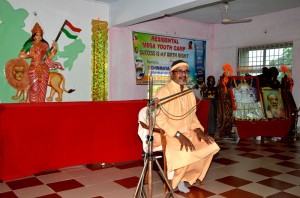 Chinmaya Mission, Behrampur had organised a Residential Youth Camp at Herambalaya College, Konisi about 5 Kms from this city. The camp was from 6th Oct. to 9th Oct. ’14 where Swami Mitrananda was invited to be camp Acharya. The Camp theme was “SUCCESS IS MY BIRTH RIGHT. I MUST ATTAIN IT“. The camp was attended by 116 participants from all corners of the state of Odisha There was wide spread appreciation for the approach under leadership of Br. Sankarshan, the resident Acharya. Some of the local colleges had postponed their internal examinations to maximise their representation in the camp. H.H. Swamy Sadananda the Regional Head for State of Odisha inaugurated the camp and offered an effective deliberation for the youngsters. Following Acharyas took classes during the camp:
Chinmaya Mission, Behrampur had organised a Residential Youth Camp at Herambalaya College, Konisi about 5 Kms from this city. The camp was from 6th Oct. to 9th Oct. ’14 where Swami Mitrananda was invited to be camp Acharya. The Camp theme was “SUCCESS IS MY BIRTH RIGHT. I MUST ATTAIN IT“. The camp was attended by 116 participants from all corners of the state of Odisha There was wide spread appreciation for the approach under leadership of Br. Sankarshan, the resident Acharya. Some of the local colleges had postponed their internal examinations to maximise their representation in the camp. H.H. Swamy Sadananda the Regional Head for State of Odisha inaugurated the camp and offered an effective deliberation for the youngsters. Following Acharyas took classes during the camp:
Narayaneeyam Chanting at Chinmaya Maauli Ashram
Narayaneeyam Chanting was organized at Chinmaya Maauli Ashram, Pune, on the auspicious day of Kartik Paurnima on Saturday 6th December 2014. This was first of it’s kind programme organized in the Chinmaya Maauli Ashram. After early morning travel and assembled at Ashram. At 9 am, after breakfast programme started with Vishnu-Sahasranam Chanting by Swami Siddheshanandaji. Brahmacharini Maitreyi oranised beautifully decorated Puja alter with very handsom “Guru Vayur” Vigraha. Shashikala Amma started leading the chanting in her melodious voice in chores with all the devotees present. Rathna Amma coordinated the whole group’s transport and logistics. At various stages Puja was performed by Brahmacharini Maitreyi. At every avatara, special naivedyam was prepared by Lalatha Ramanathan Amma. Children men and women all participated in the event with great joy and experienced divine time. Sattvik Lunch was provided at the Ashram in the afternoon break. Second session of the chanting started with little one chanting Chatushloki Bhagavatam. Programme concluded at 5 pm, with Narayan Bhajan and Veidic Aarati with Shanti Path.
Hari: Om! Tat Sat ! Narayanrpanamastu.
Narayaneeyam
Srimannarayaneeyam is a masterly condensation of the famous Bhagavat Mahapurana and was composed by Melapathur Narayana Bhattatiri, a great devotee-poet who lived in Kerala during the 16th Century A.D. The Bhagavata consisting of about 18000 verses, has been summarized in this work in 1034 verses, divided into 100 dasakas (cantos). In the 100th Canto the poet says that he has named this work as Narayana-iyam (of Narayan) for two reasons – 1. It is about Lord Narayana and 2. The poet’s name is also Narayana. As a devotional hymn, this work ranks among the best of its kind. The superiority of the path of devotion, as compared with the paths of action (karma) and Knowledge (Jnana) is repeatedly stressed by the poet. He points out that Bhakti grows in the heart of an individual without any special effort on his part if he merely listens to the narrations about the incarnations and the deeds and excellences of the Lord. In these days when life is full of tensions and problems, the reading of at least a few verses every day is the surest way to preserve one’s equanimity and enjoy inward peace. To chant this on the great day of Kartik Pournima also, has a special significance and great importance. Pujya Gurudev Swami Chinmayananda ji says Melapathur Narayan Bhattatiri was a unique personality: erudite Sanskrit scholar, poet, Bhakta, Vedantin. Imagine the audacity of a young man in his twenties attempting a summary of Vyasa’s Bhagawatam in Sanskrit hymns! And see also the literary beauty, devotional content and Vedantic insight built into NARAYANEEYAM by Bhattatiri. Nothing short of poetic frenzy could have created such a touching hymn. NARAYANEEYAM is also a standing monument to Bhattatiri’s deep insight in Vedanta.
Spiritual Excursion to SriLanka by members of CM Guwahati
This year a group of 22 devotees from CHinmaya Mission Guwahati participated in the Spiritual Excursion to SriLanka from 25th Manoranjan Rath, Secretary, CM Guwahati lead the Spiritual Excursion- a Devi Group initiative. Before leaving for SriLanka, the Group visited Chinmaya Heritage, Chennai and received blessings from Pujya Swami Mitranandaji and also visited Tirupati. In SriLanka, the group visited Ramboda, Nuwara Elliya, Kandy, Bentota and Colombo. The participants were excited to visit Ram Bhakta Hanuman Temple, Sita Temple, Gayatri Temple with 108 live Shiva Lingams, SriLankadhiswar Temple and Tooth Relic of Buddha and also other Hindu temples. The group also had the opportunity of seeing many other sites of interest in SriLanka and Macwood Tea Estate, Tea Factory & Museum, Royal Botanical Garden, Art & Handicraft Institute, Elephant Orphanage, Famous Water Falls- St. Clear Falls & Devon Falls, Spice & Herbal Garden, Kandy Traditional Cultural Dance, Bentota & Colombo Sea Beaches of vast Indian Ocean, Victoria Park, Independence Memorial, Colombo Port, Laksala were few of them. The group also visited CM Colombo and received blessings from Br. Darshan Chaitanya and Br. Jagrata Chaitanya. The participants sang Ram bhajans at CM Colombo before Paduka Puja programme on the occasion of Tapovan & Geeta Jayanti. Before leaving Colombo, the group also visited market for shopping and returned finally on 4th and spiritually.
Reviews on Premier of On A Quest
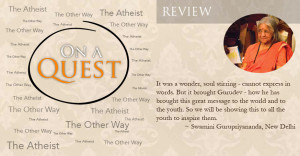
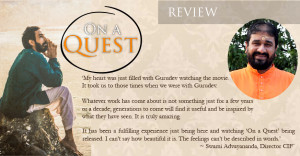
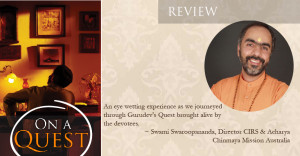 Speechless! Spellbound! Touched! Uplifted! Overwhelming! Inexplicable was the experience of watching ‘On a Quest’, the docu-drama produced by Chinmaya Creations on the life and mission of Pujya Gurudev Swami Chinmayananda. The two hour docu-drama directed by noted DirectorR S Prasanna very succinctly brings to life the journey of the young atheist Balakrishna Menon as he transforms from being a fiery revolutionary, sceptical academician, questioning journalist into a seeker with an ardent Quest for the Truth finally becoming a visionary Master carrying the message of the Rishis to the masses across the world. The entire project was led by Swami Mitrananda, Chinmaya Mission Chennai and director of All India Chinmaya Yuva Kendra who is well known for ably carrying out
Speechless! Spellbound! Touched! Uplifted! Overwhelming! Inexplicable was the experience of watching ‘On a Quest’, the docu-drama produced by Chinmaya Creations on the life and mission of Pujya Gurudev Swami Chinmayananda. The two hour docu-drama directed by noted DirectorR S Prasanna very succinctly brings to life the journey of the young atheist Balakrishna Menon as he transforms from being a fiery revolutionary, sceptical academician, questioning journalist into a seeker with an ardent Quest for the Truth finally becoming a visionary Master carrying the message of the Rishis to the masses across the world. The entire project was led by Swami Mitrananda, Chinmaya Mission Chennai and director of All India Chinmaya Yuva Kendra who is well known for ably carrying out
The movie premier was held at Sathyam Cinema on the morning of 15th December 2014 in the presence of Pujya Guruji Swami Tejomayanandaji, Global Head of Chinmaya Mission, senior swamins, young and old devotees from across India and from abroad, the main actors and the technicsl team behind the movie. The program began with a brief introduction by Swami Mitrananda.
After the movie screening the actors, donors and the team behind the making of the movie was felicitated by Guruji by who presented each one with a memento. Choked beyond words Guruji barely managed to mouth that he was speechless. He especially appreciated the work of Swami Mitrananda who led the project from start to finish including the writing of the script.
The movie was very well received. Not an eye was left dry by the end. Here are a few of the heartwarming comments received –
An eye wetting experience as we journeyed through Gurudev’s Quest brought alive by the devotees.
~ Swami Swaroopananda
It is a brilliant movie, excellently conceived, throughly brought out, with actors mostly resembling the original real life characters. It captured the hearts of the viewers and turned them emotional and devotional. Congratulations to one and all. Swami Mitranandaji’s efforts are specially very laudable. In the end I would only say – “HE DID IT… AGAIN”. Jai Gurudev.
~Swami Chidrupananda
‘I was overwhelmed. The movie was emotionally-moving and intellectually appealing. Its true to its name – On a Quest. It can begin a person’s quest, answer a seeker’s quest and will help many to understand Pujya Gurudev’s Quest. HIS journey from an atheist to an Advaitin and is depicted in a very powerful and transformational way. My Salutations to You Swamiji for such an amazing and unbelievable movie in such a short span of time.’ ~ Swami Swatmananda
Thank you very much for filling our hearts with joy and the emotions of travelling with Gurudev’s life. ~ Br Kushal Chaitanya ‘You are blessed. You have given as an incredible and priceless gift from Pujya Gurudev. Narender called me immediately after the screening of the film. He said the audience was left speechless! He described his experience – continuously tears of gratitude to Pujya Gurudev were streaming down his face. It has brought Him back in life to many. How His life was lived and what He, our Pujya Gurudev has given us – a pouring of His Heart of Knowledge lived, which you have so wonderfully projected on screen to transform many. Thank you dear Pujya Swamiji.’ ~ Kshama Metre, National Director CORD This was one of the most heartening experiences. And we are very glad the movie has turned out at well as it did and our best regards and compliments to the actors who have all dedicated themselves to this project and also to the director and of course to Swami Mitrananda who has made it all possible. ~ Pranji Lodhia, CMW Director I was truly and thoroughly impressed by the movie. It is very well done. The message is very clear. Considering the fact that we had a limited budget and new actors, it is very well done. It can’t be done any better than this. Of course we can always improve on what we did, but this is as good as it comes.
~ Shri Apparao, CMW Director
It was a moving experience – ON A QUEST.
~ Geeta menon, Director of Chinmaya Academy of Management
The film was stupendous. Thank you. Gurudev is pleased and smiling.
~ Parvathy Raman, Editor Tapovan Prasad
An overwhelming, inexplicable experience. The movie is still playing on my mind. It feels like I was again with Gurudev in person today. Extremely grateful to Swami Mitranandaji for this movie and this fulfilling experience.
~ Rukma Naik Sadekar, Editor Chinmaya Udghosh
Beyond words such was the experience seeing ON A QUEST. Our pranams and heartiest congratulations to our Swami Mitrananda.
~ Jaya Melwani, Jakarta
Hari Om! Swamiji, thank you for making us delve into such emotional depths! No words would be enough so won’t say much… Loved the one liners – will contemplate on them.
~ Nirmal Bharwani, Singapore
Thank you Swamiji….for making us part of thy gift to Him. Very grateful to thee!
~ Charmy Shah, Yuvaveer
So beautiful and touching! Cried the whole way through. Kudos! To the whole team and our beloved Swami Mitrananda.
~ Harsha, Chennai
The documentary was very well done and quite impressive. I am sure Pujya Gurudev will be happy in heaven. Hearty congratulations.
~ CMK Reddy
We are so proud to be part of today’s special screening. What a well-made movie, carefully planned and beautifully executed! The team must have been truly inspired to be able to create this end result. Once again congratulations on this most prayerful achievement.
~ Lakshmi, Jakarta
The movie has been made from the heart and that’s why the joy is palpable in every second of it.
~ Madan Mohan
‘A wonderful emotional journey through the life of our Guru.’
~ Lolita Lodhia
It was an extraordinary experience and it brought back a lot of old memories of being with Gurudev and what a fantastic thing all around – the sound, the acting was all great.
~ Gulu Jagtiani, USA
‘Many thanks for all the love and affection showered on me. Truly from my heart. The effort of Swamiji and his Young Team deserves a great applause! I sincerely feel that it was my destiny to play the role of Swami Sivananda Maharaj and you were instrumental in making it happen. All the applause or praise I have received today, I offer unto HIM!’
~ Rajeev
That moment when you see the team’s effort bloom into an awesome beautiful flower! Movie was too good. It moved everyone into tears. Hats off to the team and humble pranams and gratitude to The Man who conceptualized It.
~ Akash Nair, Yuvaveer
Thank you for giving me an opportunity to be a part of this journey. It is such a great blessing to be able to take part in this venture. Thank you again Swamiji.
~ Archana Kini, Chyk Chennai
Hats off to the creators of ‘On a Quest’. Heartfelt gratitude and salutations to everyone who’s been part of it for bringing out what’s difficult to show- in the best possible way!
~ Radha
It’s really a very heart moving moment. Thank you Swamiji.
~ Bhargavi, Chyk Chennai
The movie is just amazing, and it was my pleasure to be a part of the proceedings of the past couple of days, I will cherish this forever.
~ Simren
I am feeling blessed. I have not come out from the film. Really feeling blessed to have watched the preview. So many changes within me… can’t believe. A wonderful experience. Thank u Swamiji. This much happiness and changes is all because of you. Eagerly waiting for the release in January. My son Sivaram’s first film in a theatre… ‘On a Quest. Blessed! Blessed! Blessed! Blessed! Blessed! Blessed! Blessed! Blessed! Hurray!
~ Indumathi
It’s because he whispers to me daily …”be aware” ” I am not the body” “be the seeker” “unfold and you will find the truth”…it is this love for me that graces my life so now when the story unfolds on screen and the protagonist goes from a non believer to a believer, I understand the impact and power this man has over people. It is this magic, this compassion, this vision that “the Quest” has captured.
I am grateful to have been part of something that is bigger than me His vision has been represented with such detail and finesse capturing all his love for humanity. With this movie generation to come will know him and love him as I do.
Thank you Swamiji for making this movie and allowing his love to transcend time.
~ Rajika
Check out the video on review of the Premier on facebook
Bhashya Parayana at Chinmaya Vibhooti
The centenary celebration of a Master whose lifetime was dedicated and devoted to first learning and then teaching the Scriptures, calls for a grand and glorious start! Chinmaya Mission centers across the globe will be celebrating the 100th birth anniversary of Pujya Gurudev Swami Chinmayananda from May 2015 to May 2016, in countless inspired ways. What better prelude to the momentous occasion than to host over one hundred mahatmas at the Mission’s very own Vision Centre in Kolwan, Pune.
It would not be far-fetched to say that the Himalayas themselves came to pay their respects at Chinmaya Vibhooti from 15th to 28th November 2014, in the form of the timeless knowledge that hails from the blessed region. That was indeed the main objective of Pujya Guruji Swami Tejomayananda’s idea to organize a program where the Sankara Bhashya Parayana, or reading of the commentaries of Adi Sankaracharya, would take place. Such an event would pay homage to the tireless contribution made by Adi Sankara to Advaita Vedanta itself, and would truly mark the spirit of knowledge, sought and taught. That very knowledge which was expounded by Pujya Gurudev during more than 40 years of service to mankind.
Bhagavadpada Bhakta Mandali, a group of Parayana-kartas with their base at Somashram in Uttarkashi, was invited to chant the Sanskrit commentaries by Adi Sankara, on the Upanishads, Brahma Sutras, and Bhagavad Gita (known as the prasthana trayi), as well as a short portion of the commentary on Shri Vishnusahasranama each day, for 12 days. This took place in a very systematic manner on the stage of Sudharma auditorium, with two groups on stage, one reading and one listening.
A day before the Bhashya chanting began, the sun peeked out from behind grey clouds that showered blessings in the form of raindrops – an auspicious start indeed, and most unexpected in the month of November in Maharashtra! The entire surroundings became clean, green, and pristine! Swami Sharadananda of Chinmaya International Foundation, appointed overall event co-coordinator by Pujya Guruji, had instructed the pujari at Pranav Ganesh Mandir to arrange a special morning puja and havan to invoke divine blessings on the event.
The rain continued as Vedic mantras were later chanted at the Chinmaya Maruti Mandir to welcome the visiting sadhus and sadhvis as well as several Chinmaya Mission acharyas, to a solemn start to the proceedings. A set of Bhashya books in a palki then led the way in a splendid shobha yatra, complete with an orange flag in the hand of each sannyaasi who followed. Witnesses to the procession were fortunate to be part of such a spiritually charged moment in time. The yatra made its way from the top end of the Sundaraangan plaza to the lower end, where it met a poornakumbha and red carpet reception to the Sudharma doors. Nothing less than the very best for the beloved Masters being represented.
Once inside, the Bhashya set was placed at the altar with due respect and reverence. The stage was spectacularly arranged so that at one altar there was a Guru Parampara photo, and at the other were the presiding deities of Chinmaya Vibhooti – Pranav Ganesh Bhagwan & Chinmaya Maruti Bhagwan. In the center was a breath taking life-sized cutout of Bhagwan Adi Sankaracharya seated on an ornate throne, blessing the proceedings. Swami Medhananada Puriji Maharaj of Kailas Ashram, Rishikesh, and other learned mahatmas formally inaugurated the program by speaking of the greatness of Adi Sankara’s works, expressing joy that there are still people who have value enough to organize and attend such an event. Pujya Guruji himself spoke of the importance of seekers familiarizing themselves with these great teachings and the need for further exposure still. Swami Vishnu Tirthaji Maharaj shared an introduction to Brhadaaranyaka Upanishad, the text for evening talks by various acharyas for the next 12 days.
From the following day, what unfolded was a beautiful collaboration and connection between all present. There was an atmosphere of mutual love and respect between the visiting mahatmas and the acharyas and devotees of Chinmaya Mission. All would come together every evening for the Upanishad discourse followed by a Q&A session. Before dinner there would be a cultural evening, sometimes a screening of “Upanishad Ganga” and sometimes a bhajan program. Many Chinmaya Mission swamis would join in with the Bhashya reading on stage during the day, while an army of brahmacharis provided behind-the-scenes support in every area of organization, in particular at the Annashree.
Bhiksha was an elaborate affair with the sadhus comfortably seated in the traditional low “path and chaurang” style. Sevak teams expertly and very quickly served the rows of sadhus amidst the elevating sounds of Vedic chanting. Visitors and residents could not help but stop and marvel at the wondrous site of so many sadhus partaking of bhiksha together in this way. More than 125 families from around the world had lovingly and spontaneously come forward to offer bhiksha, and each day a long list of names was announced. Such is the heart-warming value and respect that Chinmaya Mission devotees have for sannyaasis. Those present received blessings via a token at the hands of Pujya Guruji. All later received a personalized letter and a photo collage.
For the final three days of the event, the present batch of Vedanta course students from Sandeepany Sadhanalaya visited and contributed to the study and sadhana focus. As the program came to a close on the crisp bright morning of 28th November, there was a beautiful spirit of absolute devotion unto the feet of the Guru, poignantly summed up by an archana at the padukas of Pujya Gurudev. Each and every Vakta (speaker), Parayana-karta (reader), srota (listener), and acharya came up to the stage to receive dakshina as a token of love and gratitude from Pujya Guruji, including a specially designed Om lamp memento.
How beautiful are the ancient Vedic traditions, which beautify even modern culture by remaining as applicable and beneficial today as they always were. The mahatmas present all had great appreciation for the wonderful work being done by Chinmaya Mission to preserve the vast and vital Vedic heritage, for so many to seek grace and delight from. May the teachings of Bhagwan Adi Sankara and the grace of Pujya Gurudev continue to inspire and bless all on this glorious path.
Unto Him Our Best!
Hari Om!
